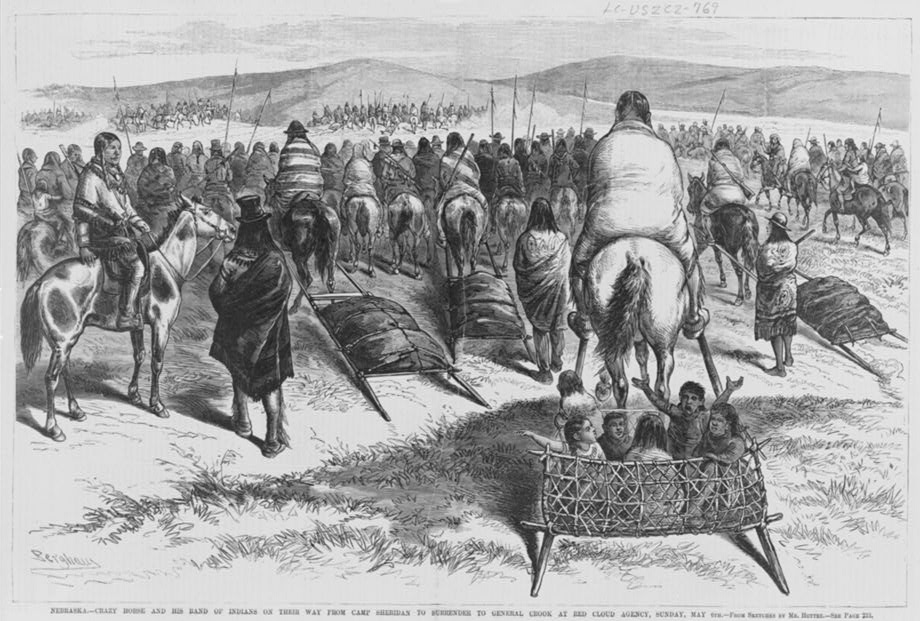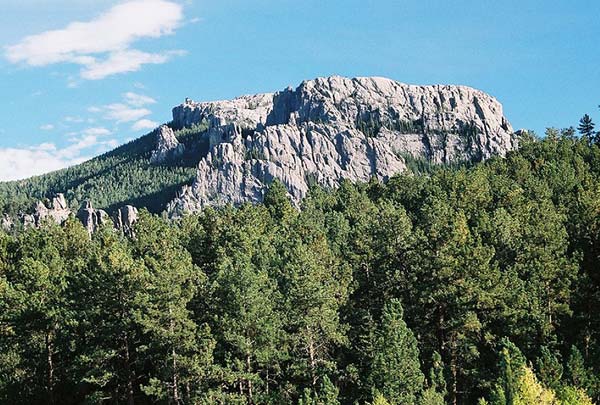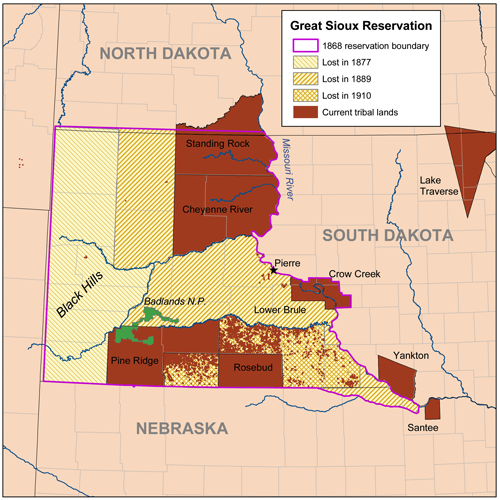|
Reva, South Dakota
Reva is an Unincorporated area, unincorporated community in Harding County, South Dakota, Harding County, South Dakota, United States. Although not tracked by the United States Census Bureau, Census Bureau, Reva has been assigned the ZIP code of 57651. The community has the name of Reva Bonniwell, the daughter of a first settler. It is the location of the annual Reva Turtle Races. History The Battle of Slim Buttes occurred here on September 9–10, 1876, in the Great Sioux Reservation between the United States Army and Miniconjou Sioux during the Great Sioux War of 1876. It marked the first significant victory for the Army since the stunning defeat of General George Armstrong Custer, George Custer at the Battle of Little Bighorn in June. One hundred fifty troopers led by Captain Anson Mills from the 3rd U.S. Cavalry surrounded the village of thirty-seven lodges and attacked it the next morning, shooting anyone who resisted. Taken by surprise, the Native Americans fled, with a mor ... [...More Info...] [...Related Items...] OR: [Wikipedia] [Google] [Baidu] |
Unincorporated Area
An unincorporated area is a parcel of land that is not governed by a local general-purpose municipal corporation. (At p. 178.) They may be governed or serviced by an encompassing unit (such as a county) or another branch of the state (such as the military). There are many unincorporated communities and areas in the United States and Canada, but many countries do not use the concept of an unincorporated area. By country Argentina In Argentina, the provinces of Chubut Province, Chubut, Córdoba Province (Argentina), Córdoba, Entre Ríos Province, Entre Ríos, Formosa Province, Formosa, Neuquén Province, Neuquén, Río Negro Province, Río Negro, San Luis Province, San Luis, Santa Cruz Province, Argentina, Santa Cruz, Santiago del Estero Province, Santiago del Estero, Tierra del Fuego Province, Argentina, Tierra del Fuego, and Tucumán Province, Tucumán have areas that are outside any municipality or commune. Australia Unlike many other countries, Australia has only local go ... [...More Info...] [...Related Items...] OR: [Wikipedia] [Google] [Baidu] |
Miniconjou
The Miniconjou (Lakota: Mnikowoju, Hokwoju – ‘Plants by the Water’) are a Native American people constituting a subdivision of the Lakota people The Lakota (; or ) are a Native Americans in the United States, Native American people. Also known as the Teton Sioux (from ), they are one of the three prominent subcultures of the Sioux people, with the Eastern Dakota (Santee) and Western D ..., who formerly inhabited an area in western present-day South Dakota from the Black Hills in to the Platte River. The contemporary population lives mostly in west-central South Dakota. Perhaps the most famous Miniconjou chief was Touch the Clouds. Historic Miniconjou thiyóšpaye or bands Together with the Sans Arc (''Itázipčho'', ''Itazipcola'', ''Hazipco'' – ‘Those who hunt without bows’) and Two Kettles (''Oóhe Núŋpa'', ''Oóhenuŋpa'', ''Oohenonpa'' – ‘Two Boiling’ or ‘Two Kettles’) they were often referred to as ''Central Lakota'' and divided into sev ... [...More Info...] [...Related Items...] OR: [Wikipedia] [Google] [Baidu] |
Crazy Horse
Crazy Horse ( , ; – September 5, 1877) was a Lakota people, Lakota war leader of the Oglala band. He took up arms against the United States federal government to fight against encroachment by White Americans, White American settlers on Native Americans in the United States, Native American territory and to preserve the traditional way of life of the Lakota people. His participation in several famous battles of the Black Hills War on the northern Great Plains, among them the Fetterman Fight in 1866, in which he acted as a decoy, and the Battle of the Little Bighorn in 1876, in which he led a war party to victory, earned him great respect from both his enemies and his own people. In September 1877, four months after surrendering to U.S. troops under General George Crook, Crazy Horse was fatally wounded by a bayonet-wielding military guard while allegedly resisting imprisonment at Fort Robinson, Camp Robinson in Pine Ridge (region), northwestern Nebraska. He was honored by ... [...More Info...] [...Related Items...] OR: [Wikipedia] [Google] [Baidu] |
Cheyenne People
The Cheyenne ( ) are an Indigenous people of the Great Plains. The Cheyenne comprise two Native American tribes, the Só'taeo'o or Só'taétaneo'o (more commonly spelled as Suhtai or Sutaio) and the (also spelled Tsitsistas, The term for the Cheyenne homeland is ''Tsistano''. Language The Cheyenne of Montana and Oklahoma speak the Cheyenne language, known as ''Tsėhésenėstsestȯtse'' (common spelling: Tsisinstsistots). Approximately 800 people speak Cheyenne in Oklahoma. There are only a handful of vocabulary differences between the two locations. The Cheyenne alphabet contains 14 letters. The Cheyenne language is one of the larger Algonquian-language group. Formerly, the Só'taeo'o (Só'taétaneo'o) or Suhtai (Sutaio) bands of Southern and Northern Cheyenne spoke ''Só'taéka'ėškóne'' or ''Só'taenėstsestȯtse'', a language so close to ''Tsėhésenėstsestȯtse'' (Cheyenne language), that it is sometimes termed a Cheyenne dialect. History The earliest written reco ... [...More Info...] [...Related Items...] OR: [Wikipedia] [Google] [Baidu] |
Brulé
The Sicangu are one of the seven ''oyates'', nations or council fires, of Lakota people, an Indigenous people of the Northern Plains. Today, many Sicangu people are enrolled citizens of the Rosebud Sioux Tribe of the Rosebud Indian Reservation and Lower Brule Sioux Tribe of the Lower Brule Reservation in South Dakota. Distribution Many Sičhą́ǧu people live on the Rosebud Indian Reservation in southwestern South Dakota and are enrolled in the federally recognized Rosebud Sioux Tribe, also known in Lakȟóta as the ''Sičhą́ǧu Oyáte.'' A smaller population lives on the Lower Brule Indian Reservation, on the west bank of the Missouri River in central South Dakota, and on the Pine Ridge Indian Reservation, also in South Dakota, directly west of the Rosebud Indian Reservation. The different federally recognized tribes are politically independent of each other. Name The Sicangu Lakota are known as Sičhą́ǧu Oyáte in Lakȟóta, which translates to "Burnt Thighs N ... [...More Info...] [...Related Items...] OR: [Wikipedia] [Google] [Baidu] |
Sans Arc
The Sans Arc or Itázipčho are one of the seven subdivision of the Lakota people. They primarily live in the Cheyenne River Indian Reservation in South Dakota. Name ''Itázipčho'' is also written ''Itazipcola'' or ''Hazipco'' and is a Lakota term translating as "those who hunt without bows." ''Sans Arc'' is the French translation, meaning "without bows". The translator of '' Wooden Leg: A Warrior Who Fought Custer'' renders the name as Arrows all Gone. One of the many etymologies of the Lakota name tells the following story: The true meaning of ''Itazipacola'' is "no markings". This referred to the fact that the ''Itazipco'' were so generous they did not mark their arrows (they were usually marked so that braves could claim the bison they killed, etc.), that way everyone could share the meat of the hunt. This is why when the Creator wanted to give the pipe to the ''Lakota'', the White Buffalo Woman ''Wopi'' brought it to the ''Itazipco'', because they would always be willing ... [...More Info...] [...Related Items...] OR: [Wikipedia] [Google] [Baidu] |
American Horse (elder)
American Horse (Oglala Lakota: ''Wašíčuŋ Tȟašúŋke'' in Standard Lakota Orthography) (a/k/a "American Horse the Elder") (c. 1830–September 9, 1876) was an Oglala Lakota warrior chief renowned for courage and honor. American Horse is notable in American history as one of the principal war chiefs allied with Crazy Horse during Red Cloud's War (1866–1868) and the Battle of the Little Bighorn during the Great Sioux War of 1876–1877. Chief American Horse was a son of Old Chief Smoke, an Oglala Lakota head chief and one of the last great Shirt Wearers, a highly prestigious Lakota warrior society. He was a signatory to the Fort Laramie Treaty of 1868, along with his brothers Chief Red Cloud and Chief Blue Horse. A month or so after the Treaty, American Horse was chosen a ''"Ogle Tanka Un"'' (Shirt Wearer, or war leader) along with Crazy Horse, They Even Fear His Horses and Man That Owns a Sword. On September 9, 1876, American Horse was mortally wounded in the Battle of Slim B ... [...More Info...] [...Related Items...] OR: [Wikipedia] [Google] [Baidu] |
3rd U
Third or 3rd may refer to: Numbers * 3rd, the ordinal form of the cardinal number 3 * , a fraction of one third * 1⁄60 of a ''second'', i.e., the third in a series of fractional parts in a sexagesimal number system Places * 3rd Street (other) * Third Avenue (other) * Highway 3 Music Music theory * Interval number of three in a musical interval **Major third, a third spanning four semitones **Minor third, a third encompassing three half steps, or semitones **Neutral third, wider than a minor third but narrower than a major third ** Augmented third, an interval of five semitones **Diminished third, produced by narrowing a minor third by a chromatic semitone *Third (chord), chord member a third above the root *Degree (music), three away from tonic **Mediant, third degree of the diatonic scale **Submediant, sixth degree of the diatonic scale – three steps below the tonic ** Chromatic mediant, chromatic relationship by thirds *Ladder of thirds, similar to the ... [...More Info...] [...Related Items...] OR: [Wikipedia] [Google] [Baidu] |
Anson Mills
Anson Mills (August 31, 1834 – November 5, 1924) was a United States Army officer, surveyor, inventor, and entrepreneur. Engaged in south Texas as a land surveyor and civil engineer, he both named and laid out the city of El Paso, Texas. Mills also invented a woven cartridge belt which late in life made his fortune. Biography Mills was born on a farm near Thorntown, Indiana, the first of nine children to a father and mother of Quaker ancestry but with no particular interest in religion. As a young man, Mills worked on the farm but also became a practiced carpenter and weaver. In 1855, he entered West Point but in 1857 was dismissed for "deficiency in mathematics." Too embarrassed to return home, he taught school in McKinney, Texas and then moved on to El Paso to work as a surveyor, which included drawing up the original plat of the town. When the Civil War broke out in 1861, he accepted a commission as a first lieutenant in the regular 18th Infantry regiment of the U.S. Army. H ... [...More Info...] [...Related Items...] OR: [Wikipedia] [Google] [Baidu] |
Battle Of Little Bighorn
The Battle of the Little Bighorn, known to the Lakota and other Plains Indians as the Battle of the Greasy Grass, and commonly referred to as Custer's Last Stand, was an armed engagement between combined forces of the Lakota Sioux, Northern Cheyenne, and Arapaho tribes and the 7th Cavalry Regiment of the United States Army. It took place on June 25–26, 1876, along the Little Bighorn River in the Crow Indian Reservation in southeastern Montana Territory. The battle, which resulted in the defeat of U.S. forces, was the most significant action of the Great Sioux War of 1876. Most battles in the Great Sioux War, including the Battle of the Little Bighorn, were on lands those natives had taken from other tribes since 1851. The Lakotas were there without consent from the local Crow tribe, which had a treaty on the area. Already in 1873, Crow chief Blackfoot had called for U.S. military actions against the native intruders. The steady Lakota incursions into treaty areas belonging ... [...More Info...] [...Related Items...] OR: [Wikipedia] [Google] [Baidu] |
George Armstrong Custer
George Armstrong Custer (December 5, 1839 – June 25, 1876) was a United States Army officer and cavalry commander in the American Civil War and the American Indian Wars. Custer graduated from the United States Military Academy at West Point, New York, last in his graduating class of 1861 (34th out of a starting class of 108 candidates, 68 passing the entrance exam, of whom 34 graduated). Nonetheless, Custer achieved a higher military rank than any other U.S. Army officer in his class. Following graduation, he worked closely with future Union Army Generals George B. McClellan and Alfred Pleasonton, both of whom recognized his abilities as a cavalry leader. He was promoted in the early American Civil War (1861–1865), to brevet Brigadier general (United States), brigadier general of volunteers when only aged 23. Only a few days afterwards, he fought at the pivotal Battle of Gettysburg in Pennsylvania in early July 1863, where he commanded the Michigan Brigade. Despite being ou ... [...More Info...] [...Related Items...] OR: [Wikipedia] [Google] [Baidu] |
Great Sioux War Of 1876
The Great Sioux War of 1876, also known as the Black Hills War, was a series of battles and negotiations that occurred in 1876 and 1877 in an alliance of Lakota people, Lakota Sioux and Northern Cheyenne against the United States. The cause of the war was the desire of the US government to obtain ownership of the Black Hills. Gold had been discovered in the Black Hills, settlers began to encroach onto Native Americans in the United States, Native American lands, and the Sioux and the Cheyenne refused to cede ownership. Traditionally, American military and historians place the Lakota at the center of the story, especially because of their numbers, but some Native Americans believe the Cheyenne were the primary target of the American campaign. Among the many battles and skirmishes of the war was the Battle of the Little Bighorn - often known as ''Custer's Last Stand'' and the most storied of the many encounters between the US Army and mounted Plains Indians. Despite the Indian vict ... [...More Info...] [...Related Items...] OR: [Wikipedia] [Google] [Baidu] |







